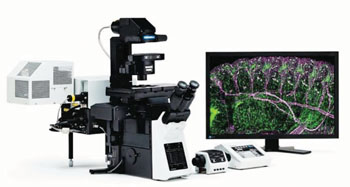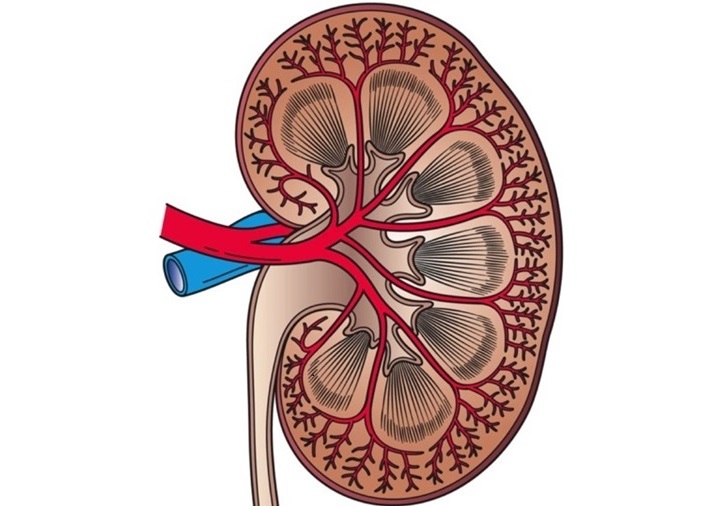Protein Biomarker Signals More Aggressive Prostate Cancer
|
By LabMedica International staff writers Posted on 05 May 2015 |

Image: The FluoView 500 Laser Scanning Confocal Microscope (Photo courtesy of Olympus Inc.).
Prostate cancer (PCa), the most common male malignancy, is frequently associated with bone metastases and a major challenge for treatment is to identify factors controlling tumor growth and metastasis.
The metastatic process begins in the primary tumor with activation of genes that promote angiogenesis, the development of new blood vessels, tumor invasion and migration leading to colonization of peripheral tissues including bone.
Scientists at the University of Michigan (Ann Arbor, MI, USA) and their Italian colleagues investigated whether adding a phosphate group, a process called phosphorylation, to the protein Runt-related transcription factor 2 (Runx2), changes its structure to activate specific genes in both bone and prostate cancer cells, but with vastly different results. Bone cells need Runx2 and the newly roused genes to make healthy bone. However, in prostate cancer cells, Runx2 triggered genes that fuel tumor growth and metastasis. They analyzed tissue samples from 129 patients with prostate cancer.
The team used various techniques in the study including Western blot analysis and immunofluorescence, transient transfections, luciferase reporter assays and virus transduction, cell migration and cell invasion assays, and immunohistochemistry. Fluorescence was detected using an Olympus FluoView 500 Laser Scanning Confocal Microscope (Olympus Inc., Waltham, MA, USA). Tissue samples from a total of 129 Caucasian patients with prostate disease were used to construct tissue microarrays.
The investigators found little or no Runx2 phosphorylation in normal prostate, benign prostate or prostatitis, which suggests that Runx2 phosphorylation is closely associated with the more aggressive forms of prostate cancer. The next step is to establish an actual cause-effect relationship between Runx2 phosphorylation and prostate cancer. Renny T. Franceschi, PhD, the senior author of the study said, “If this biomarker does indeed control the growth of prostate cells, it's a new signal that's not been seen before and could provide a potential new drug target for prostate cancer. It could also be a potential biomarker to discriminate between fast and slow growing tumors.” The study was published on April 13, 2015, in the journal Oncogene.
Related Links:
University of Michigan
Olympus Inc.
The metastatic process begins in the primary tumor with activation of genes that promote angiogenesis, the development of new blood vessels, tumor invasion and migration leading to colonization of peripheral tissues including bone.
Scientists at the University of Michigan (Ann Arbor, MI, USA) and their Italian colleagues investigated whether adding a phosphate group, a process called phosphorylation, to the protein Runt-related transcription factor 2 (Runx2), changes its structure to activate specific genes in both bone and prostate cancer cells, but with vastly different results. Bone cells need Runx2 and the newly roused genes to make healthy bone. However, in prostate cancer cells, Runx2 triggered genes that fuel tumor growth and metastasis. They analyzed tissue samples from 129 patients with prostate cancer.
The team used various techniques in the study including Western blot analysis and immunofluorescence, transient transfections, luciferase reporter assays and virus transduction, cell migration and cell invasion assays, and immunohistochemistry. Fluorescence was detected using an Olympus FluoView 500 Laser Scanning Confocal Microscope (Olympus Inc., Waltham, MA, USA). Tissue samples from a total of 129 Caucasian patients with prostate disease were used to construct tissue microarrays.
The investigators found little or no Runx2 phosphorylation in normal prostate, benign prostate or prostatitis, which suggests that Runx2 phosphorylation is closely associated with the more aggressive forms of prostate cancer. The next step is to establish an actual cause-effect relationship between Runx2 phosphorylation and prostate cancer. Renny T. Franceschi, PhD, the senior author of the study said, “If this biomarker does indeed control the growth of prostate cells, it's a new signal that's not been seen before and could provide a potential new drug target for prostate cancer. It could also be a potential biomarker to discriminate between fast and slow growing tumors.” The study was published on April 13, 2015, in the journal Oncogene.
Related Links:
University of Michigan
Olympus Inc.
Latest Pathology News
- AI Tool Uses Imaging Data to Detect Less Frequent GI Diseases
- AI-Based Method Shows Promise for Pathological Diagnosis of Hereditary Kidney Diseases
- New Imaging Method Opens Door to Precision Diagnostics for Head and Neck Cancers
- Faster Measurement of Vibrational Fingerprint of Molecules to Advance Biomedical Diagnostics
- Clinical Antibody Test to Quickly Detect Even Low Levels of Common Parasitic Infection
- Pioneering Microscopy Technique Improves Diagnosis of Glioblastoma Brain Tumors
- AI-Based Breast Cancer Test Uses Routine Digital Histopathology Images for Risk Stratification
- AI Model Identifies Sex-Specific Risks Associated with Brain Tumors
- Breakthrough Virus Detection Technology Combines Confocal Fluorescence Microscopy with Microfluidic Laminar Flow
- AI Technology Accurately Predicts Breast Cancer Risk Via ‘Zombie Cells’
- Liquid Biopsy Solution Enables Non-Invasive Sample Collection and Direct Cell-Free DNA Stabilization from Urine
- Innovative AI Tool Uses Digitized Whole-Slide Images for Intermediate-Risk Prostate Cancer Management
- AI-Based Tissue Staining Detects Amyloid Deposits Without Chemical Stains or Polarization Microscopy
- Super-Resolution Imaging Detects Parkinson's 20 Years Before First Motor Symptoms Appear
- New Technology for Sampling Body Liquids in Confined Spaces to Enable Early Cancer Detection
- New Technology Holistically Images Deep Living Tissue for The First Time
Channels
Clinical Chemistry
view channel.jpg)
POC Saliva Testing Device Predicts Heart Failure in 15 Minutes
Heart failure is a serious condition where the heart muscle is unable to pump sufficient oxygen-rich blood throughout the body. It ranks as a major cause of death globally and is particularly fatal for... Read more
Screening Tool Detects Multiple Health Conditions from Single Blood Drop
Infrared spectroscopy, a method using infrared light to study the molecular composition of substances, has been a foundational tool in chemistry for decades, functioning similarly to a molecular fingerprinting... Read more
Integrated Chemistry and Immunoassay Analyzer with Extensive Assay Menu Offers Flexibility, Scalability and Data Commutability
As global healthcare systems increasingly shift towards networked laboratory operational models to enhance efficiency and patient access, there is a greater need for innovative solutions tailored to the... Read moreMolecular Diagnostics
view channel
cfDNA Testing Reduces Pregnancy Risks
The highly anticipated emergence of "precision medicine" promises customized technologies that can benefit individuals while potentially lowering healthcare costs. Now, new research suggests that pregnancy... Read more
Non-Invasive Biosensor Facilitates Early Kidney Disease Detection
Traditionally, kidney function has been assessed by measuring blood creatinine levels, which reflect muscle breakdown. Elevated creatinine levels may indicate that the kidneys are not effectively filtering waste.... Read moreHematology
view channel
Next Gen CBC and Sepsis Diagnostic System Targets Faster, Earlier, Easier Results
Every hour is critical in protecting patients from infections, yet there are currently limited tools to assist in early diagnosis before patients reach a hospital. The complete blood count (CBC) is a common... Read more
Newly Discovered Blood Group System to Help Identify and Treat Rare Patients
The AnWj blood group antigen, a surface marker discovered in 1972, has remained a mystery regarding its genetic origin—until now. The most common cause of being AnWj-negative is linked to hematological... Read more
Blood Platelet Score Detects Previously Unmeasured Risk of Heart Attack and Stroke
Platelets, which are cell fragments circulating in the blood, play a critical role in clot formation to stop bleeding. However, in some individuals, platelets can become "hyperreactive," leading to excessive... Read moreImmunology
view channel.jpg)
Advanced Imaging Method Maps Immune Cell Connections to Predict Cancer Patients Survival
A growing tumor is influenced not only by the tumor cells themselves but also by the surrounding tissue, which alters its biology. Immune cells communicate by transferring vital signaling proteins to their... Read more
Computational Tool Predicts Immunotherapy Outcomes for Metastatic Breast Cancer Patients
Immunotherapy aims to enhance the body’s immune response to target cancer cells, but not all patients experience a positive reaction to such treatments. Identifying which patients will benefit from immunotherapy... Read more
Biomarker Could Predict Immunotherapy Response in Liver Cancer
Until recently, patients diagnosed with hepatocellular carcinoma had limited treatment options, with existing therapies extending life by only a few months. Immunotherapy has emerged as a new alternative... Read more
Epigenetic Test Could Determine Efficacy of New Immunotherapy Treatments Against Multiple Myeloma
Multiple myeloma is a blood cancer that primarily affects individuals over the age of sixty, and its occurrence rises as the population ages. In this disease, the bone marrow—the spongy tissue inside bones... Read moreMicrobiology
view channel
High-Accuracy Bedside Test to Diagnose Periprosthetic Joint Infection in Five Minutes
Periprosthetic joint infection (PJI) represents a significant global issue that is worsening as the number of joint replacements increases due to aging populations. In the United States alone, the anticipated... Read more_1.jpg)
Innovative Diagnostic Approach for Bacterial Infections to Enable Faster and Effective Treatment
For patients with bacterial infections, timely treatment with the appropriate antibiotics significantly improves their chances of recovery. Current methods for identifying which antibiotics will be effective... Read more
Non-Invasive Stool Test to Diagnose Endometriosis and Help Reduce Disease Progression
Endometriosis, a painful condition impacting nearly 200 million women globally, occurs when tissue similar to the lining of the uterus grows outside its usual location, such as on the intestines or the... Read more
Automated Positive Blood Culture Sample Preparation Platform Designed to Fight Against Sepsis and AMR
Delayed administration of antibiotics to patients with bloodstream infections significantly increases the risk of morbidity and mortality. For optimal therapeutic outcomes, it is crucial to rapidly identify... Read moreTechnology
view channel
New Noninvasive Methods Detect Lead Exposure Faster, Easier and More Accurately at POC
Exposure to lead can negatively affect health in multiple ways, leading to damage in the brain and central nervous system, delays in development and growth, learning and behavioral issues, problems with... Read more
Noninvasive Test Detects Malaria Without Blood Sample
Malaria remains a significant global health issue, with approximately 250 million cases and over 600,000 deaths reported annually. Nearly half of the world's population is at risk for malaria infection,... Read moreIndustry
view channel
Microbiologics Acquires Diagnostic Quality Controls Manufacturer SensID
Microbiologics (St. Cloud, MN, USA), a biotechnology company specializing in infectious disease reference materials and contract research services, has acquired SensID (Rostock, Germany), a manufacturer... Read more

















_1.jpg)
